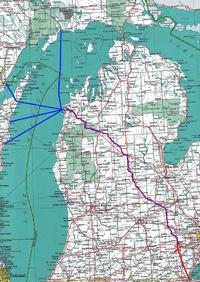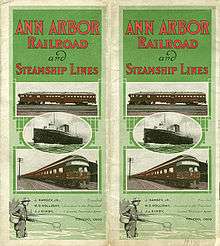Ann Arbor Railroad (1895–1976)
 | |
| Reporting mark | AA |
|---|---|
| Locale | Michigan and Ohio |
| Dates of operation | 1895–1976 |
| Track gauge | 4 ft 8 1⁄2 in (1,435 mm) standard gauge |
| Headquarters | Toledo, OH (early years), St. Louis, MO (1925-1963), Dearborn, MI (1963-1976) |

The Ann Arbor Railroad (reporting mark AA) was an American railroad that operated between Toledo, Ohio and Elberta and Frankfort, Michigan (about 294 route miles) with train ferry operations across Lake Michigan. In 1967 it reported 572 million net ton-miles of revenue freight, including 107 million in "lake transfer service"; that total does not include the 39-mile subsidiary Manistique and Lake Superior Railroad.
History
The railroad company was chartered September 21, 1895 as successor to the Toledo, Ann Arbor and North Michigan Railway.[1] In 1905 it was acquired by the Detroit, Toledo & Ironton Railway (DT&I), which went bankrupt three years later and had to sell off the Ann Arbor.
For many years the Ann Arbor was owned by the Wabash, but Wabash gave up control in 1963 as part of its absorption into the Norfolk and Western. The DT&I, by then itself owned by the giant Pennsylvania Railroad, again gained control in 1963. The combined DT&I and AA were operated as independent subsidiaries of the PRR but suffered from the parent company's ill-fated 1968 merger with the New York Central. Upon the resulting Penn Central's 1970 bankruptcy, the DT&I and its Ann Arbor subsidiary were sold off to private investors.
The Ann Arbor Railroad owned a subsidiary, the Manistique and Lake Superior Railroad (M&LS), from somewhere shortly after that line's origin in 1909 until it was abandoned in 1968.
After itself going bankrupt in 1973 the Ann Arbor ceased operations as a railroad on April 1, 1976, when the Consolidated Rail Corporation (Conrail) temporarily took over. Since Conrail only wished to operate the south end of the AA, the state of Michigan acquired the entire line, and operations were transferred to the Michigan Interstate Railway, a division of the Michigan Department of Transportation (MDOT), on October 1, 1977. The state eventually privatized this entity, selling it off in pieces to several different short-line railroad companies.
On October 7, 1988 a new Ann Arbor Railroad began operating the portion south of Ann Arbor; the Great Lakes Central Railroad now serves the remaining portions of the line. Some sections have been abandoned: from Yuma to Elberta and Frankfort (approximately 45 miles), about 10 miles in Shiawassee County, Michigan (in three discontinuous sections), and the trackage around the now-demolished Cherry Street Station in Toledo.
Train ferries
The Ann Arbor's Lake Michigan train ferry fleet started in November 1892 when the Toledo, Ann Arbor and Northern Michigan Railway acquired its first two boats, Ann Arbor 1 and Ann Arbor 2. At its height, the AA served four ports on the west of Lake Michigan:[2]
- Kewaunee, Wisconsin from 1892 connecting with Kewaunee, Green Bay and Western Railroad,
- Menominee, Michigan from 1894 connecting with Chicago, Milwaukee and St. Paul Railway, Chicago and North Western Railway, and Wisconsin and Michigan Railroad
- Gladstone, Michigan from 1895 connecting with the Minneapolis, St. Paul and Sault Ste. Marie Railroad. Later moved to Manistique, Michigan connecting with Duluth, South Shore and Atlantic Railway via AA subsidiary Manistique and Lake Superior Railroad
- Manitowoc, Wisconsin from 1896 connecting with Chicago and North Western Railway, and Wisconsin Central Railway
Fleet
Altogether, eight boats were built for service with the AA and one was leased from the Grand Trunk Milwaukee Car Ferry Company.[2]
- SS Ann Arbor No. 1 – designed by Frank E. Kirby and built by Craig Ship Building, Toledo, Ohio in 1892. Capacity 24 cars on four tracks.
- SS Ann Arbor No. 2 – designed by Frank E. Kirby and built by Craig Ship Building, Toledo, Ohio in 1892. Capacity 24 cars on four tracks.
- SS Ann Arbor No. 3 – built by Globe Iron Works, Cleveland, Ohio in 1898.
- SS Ann Arbor No. 4 – built by Globe Iron Works, Cleveland, Ohio in 1906.
- SS Ann Arbor No. 5 – designed by Frank E. Kirby and built by Toledo Shipbuilding Company in 1910.
- SS Ann Arbor No. 6 – built by Great Lakes Engineering Works, Ecorse, Michigan in 1917 and rebuilt in 1959 as the MV Arthur K. Atkinson.
- SS Ann Arbor No. 7 – built by Manitowoc Shipbuilding Company in 1925 and rebuilt in 1965 as the MV Viking.
- SS Wabash – built by Toledo Shipbuilding Company in 1927, and rebuilt in 1962 as the SS City of Green Bay.
- SS City of Milwaukee, a Grand Trunk Western vessel was leased in 1978.
See also
Further reading
- Meints, Graydon M. Michigan Railroads & Railroad Companies. MSU Press, 1993.
- Middleton, William D., George M. Smerk, and Roberta L. Diehl, eds. Encyclopedia of North American Railroads. (Indiana University Press, 2007). pp 125-26